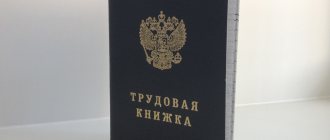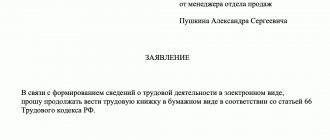Home / Labor Law / Labor book
Back
Published: 06/18/2018
Reading time: 4 min
0
277
The insert is a supplement to the work book. The need for an insert arises when there are a large number of entries in the employee’s book. There are certain rules for filling out the document.
- Why do you need an insert?
- Decor
- Who's buying
- How it is sewn in
- What to do if the liner is damaged?
Regulatory documents and acts
Despite the fact that we said earlier that not a single regulatory legal act provides an explanation of exactly how to carry out the procedure for sewing in a form, some of the acts in the field of labor legislation still talk about how to act in a situation where if the sheets in the labor report simply simply ran out.
A good example is Article 38 in Government Decree No. 225 , dated April 16, 2003, dedicated to work books.
This article establishes the fact that it is possible to sew a form into a work book, but only if the remaining pages have run out. Unauthorized entry of a form into a work record book, in which there is still free space left, is considered damage to the work record book and the document will be subject to restoration in the form of issuing a duplicate (see here).
How to sew an insert into a work book: features of the procedure
The insert is an integral part of the work record book. It is used if all pages of a particular section are completed. The insert without the main document is invalid, so the HR officer’s task is to combine both sources so that they are, from a material point of view, a single document. This is done by sewing the insert into the book.
The insert needs to be sewn in, and not stapled or glued in (clause 38 of the Government Decree “On Work Books” dated April 16, 2003 No. 225). At the same time, it is also important to observe the legal nuances of combining two sources into one.
Step-by-step instruction
Despite the fact that sewing in one sheet takes approximately ten to fifteen minutes, this procedure has a number of nuances.
Unfortunately, HR officers and employers are not familiar with them, and, to tell the truth, it is very problematic to get acquainted with them, because they are not provided for by law, however, there are clear regulations that must be observed and ignorance of its steps does not relieve one from responsibility. Therefore, let's take a closer look at these stages.
In order to correctly insert the form into the work document, you will need to perform the following steps:
- a HR specialist should inspect your work report to see if there are any blank pages;
- then he must obtain a new blank form from the human resources department or from the employer;
- registers it in the specialized book of the organization;
- puts a corresponding stamp on the form;
- fills it out;
- fills out the title page of the insert;
- puts the required entry under the required numbering.
At this point, the stages of sewing in the form are completed; now it’s worth understanding the nuances.
Where should I sew it?
Inexperienced personnel department employees have no idea where to sew the form. Many tried to stick it to the title page, to the back of the book, in the center, or simply insert it without using threads or needles.
In fact, holes are made in the form in the same place as in the book forms. The form is sewn to the spread where there is the last page of the work report. It is stitched with neat stitches, preferably with black, blue or gray threads. This completes the sewing process.
What exactly should I hem with?
Many people use various tools, including a hole punch, but in fact, the only correct tool for sewing is a regular needle and thread.
Also, an ordinary, not thin awl will help you in your business. Using an awl, you must carefully make holes in the right places on the forms, and then using a needle and thread in neutral colors, simply secure the form.
How to properly sew an insert into a work book using threads: sample work on video:
What to do if there is no stamp?
The organization must have a stamp. But it often happens that a legal entity has just begun to function, and the stamp simply has not been made yet. In this case, you can use two options for the development of events.
The first is to urgently order a stamp and receive it within a day or the next day.
You can also put information that the form is sewn in with a simple pen in the place where the stamp should be.
Using a blue or black pen, in legible handwriting, you write the phrase “insert issued” and also put a date and signature.
What if you don't sew in the liner?
It seems clear how to properly sew an insert into a work book, but what if this is not done? First of all, the owner of such a book may have problems in the future when applying for a job in another organization or when applying for a pension.
The insert itself without a work book is not valid, even if there are stamps and notes on it.
If you encounter any errors while stitching
It often happens that the form is sewn in the wrong place, or the new form is not filled out correctly. What should a HR employee do in such situations? First of all, do not panic and treat the situation rationally.
If the form is sewn incorrectly , inspect the labor document; if it is possible to detach it without damaging the labor document, do this and destroy the form.
If it is not possible to detach the form , then you will have to restore the employee’s work book, that is, make a duplicate for him.
If there are spelling errors in the form and they can be corrected, try to do this carefully by crossing out or correcting, or re-write. If there are a lot of errors and their elimination will cause dirt in the labor document, then also try to remove the form and destroy it without causing harm to the labor document.
In place of the pulled out forms, you must insert new ones with a greater degree of care.
How the insert is dispensed
It “opens” only when the work book is full. The process of preparing an insert in the work book must obey the following rules.
- last name, first name and patronymic}
- date of birth}
- information about education (diploma or certificate)}
- specialty (if it was not previously indicated, then you should not “improvise” in the insert; it is better to leave the column blank).
- The date of filling out the insert (the day the first entries were made in it), the surname, initials and signature of the responsible official, and the signature of the owner of the work book must also be entered.
We invite you to read: How to legalize an extension to a private house in 2021
After their acquisition, the forms are stored in the accounting department or with the person authorized to maintain labor records. The accounting department, after entering the purchased forms into the register of the receipt and expenditure book, transfers them to work against the signature of the person keeping the labor records.
- Issue free of charge, taking the acquisition costs under your own responsibility, in accordance with clauses 44 and 48 of the Rules.
- By charging proportionate compensation not exceeding the cost of the form, based on clause 47.
If by the time the entry is made in the insert, the forms from product sellers have increased in price, the employer has the right to charge a fee only equal to that which was paid when purchasing this particular form.
Seeing that there is a need for this document, the employer’s representative asks the employee to write an application for an insert in the work book. It is endorsed by the manager, and on the basis of the paper received from the subordinate, he also issues the corresponding order - to issue the insert to the Labor Committee.
Since the insert form is a strict reporting document, the employer buys it independently from a specialized organization. The order usually indicates the company employee responsible for acquiring and processing this personnel documentation. He acts on behalf of the company by proxy.
The stamp “issued insert in the work book”, a sample of which is offered for review below, is placed on the main document. The legislation does not regulate where it should be affixed, but in practice this is done either on the inside of the “crust” or on the title page of the TC. Before this, the insert sheets are carefully sewn into the document.
Please note: when an insert in the work book is issued, the entry, a sample of which can be found on old documents, is no longer made. The law requires that this be a stamp (clause 39 of the Rules for maintaining labor books). It indicates the number of the insert and its series.
The question of whether the insert is valid without a work book is answered by clause 38 of the above-mentioned Rules. And he answers negatively. Without the main document, it cannot be presented, since it has no legal force separately, but is a continuation of the work book.
Can I use something else instead of the liner?
The legislator did not stipulate the possibility of using a new labor document instead of the form. But if you carefully study some articles of legislation in the field of labor law, you can come to a number of answers.
The Labor Code in Article 66 states that an employee must have one work book (more details here). That is, if an employee starts a second work book, then automatically he begins to contradict the main act of our country on labor.
It is also worth remembering that maintaining a second work book can be regarded as falsification of documents, and this practice has become quite common in recent years. And the pension fund, when calculating your total work experience, will only accept one work record from you. Therefore, the question of whether it is possible to use a work book instead of a form eliminates the problem itself.
First step
How to sew an insert into a work book? You will need thread, a needle and an awl. It is imperative to make sure that there are indeed no blank sheets in the work book for recording information about admission or dismissal.
The insert should be sewn to the back page of the cover, preferably even to the spread itself. It is necessary to make several stitches so that the liner does not fall out in the future. It is recommended to use threads in muted tones.
After sewing in, the booklet and insert should form a single document. Gluing the insert or fixing it with a stapler is not allowed. This prohibition is enshrined in paragraph 38 of the Instructions for maintaining work books.
Stamping rules
When adding an appendix to the work book, a note is made on it about the new addition. Usually this is a stamp indicating the presence of an addition on the title page of the book. The following actions are carried out here:
- The title page of the main document is stamped “Insert issued” indicating the necessary details: series and number of the new attached document.
- When registering several inserts, stamps are affixed each time a new one is registered.
- If the employer does not have a stamp, you can make a note about the application by hand.
- It is imperative to ensure that new marks do not cover other, already existing inscriptions on the main document and do not interfere with the reading of previously made entries.
- If a mistake was made when filling out the attachment and the document needs to be destroyed, but the stamp has already been affixed, you will need to make a note about the invalidity of the mark.
Design nuances
If it becomes necessary to fill out an attachment, it is useful to focus on the following nuances:
- Entering data and registering attachments is carried out by the employer who has a need to make an entry if there are no free lines in the section where the necessary entry should be made.
- When filling out the title page, the HR department employee is required to indicate the actual date of completion. This means that it will differ from the date of issue of the book and is later.
- When filling out the title page of the application, you must make entries that are current at the time of registration of this attachment. For this, the employee provides a passport and a document on education or, if available, on advanced training. All data must correspond to the actual state of affairs at the time of filling. For example, an employee received a higher education after receiving a job. The insert will contain his specialty according to the new document-diploma of higher education.
- The entries made must be checked by the owner of the book and he must sign. Information about the person filling out the document must also be entered; in addition, the correctness of the entries is endorsed by the signature and seal of the employer who issued the insert. Here, you need to pay attention to whether there is a seal on the title page of the book itself in which the addition will be inserted; if the seal is not affixed, the employee should be obliged to put it on the employer who prepared the document.
- The book can contain as many inserts as are required to make all the necessary entries reflecting the employee’s work activities. There is no regulation of their number and only as many as are required to make all the entries in the labor record are registered.
The attached document must be sewn into the book. It cannot be stapled or glued in, and it cannot be stored separately from the main one.
Recommendation: First, it is advisable to fill out the title page and make the required entry, and only then attach it to the main document. It is prohibited to correct incorrect filling of the first sheet. Necessary:
- Withdraw the erroneously completed application.
- Draw up a report regarding the damaged form and destroy the incorrectly filled out form itself.
- Register the fact of the damaged form in the Book of registration of the movement of labor and inserts for them.
- Next, you should receive and write out the next insert without corrections or errors.
- Attach the completed form to the employment form.
Only after performing the actions prescribed in this case, making all the necessary entries and checking them, should you file the correctly completed new attachment to the main book.
Financial side of the issue
The insert form must be purchased by the employer, but the cost of the insert is charged to the employee for whom it is issued.
The employer must keep a sufficient supply of blank employment forms and inserts; he cannot send the employee to buy the form himself. Although in practice this situation often occurs.
What is the price
The employer may include in the price of the form insert not only the price at which it was purchased, but also the overhead costs of purchasing it, such as shipping.
The employee who receives the insert is obliged to pay for it, except for the following cases:
- Massive loss of labor.
- Damage to the form due to the fault of the employer.
The cost of the insert can be deducted in any way:
- From salary.
- By depositing cash into the cash register.
Typically, the procedure for this procedure is prescribed in the accounting policy.











